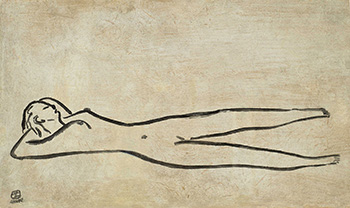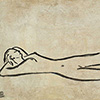ILLUSTRATED:
Rita Wong, Sanyu Catalogue Raisonné: Drawings and Watercolors,The Li Ching Cultural and Educational Foundation, Taipei, 2014,color illustrated, no. D0626, p. 51 (flash drive)
This oil painting is to be included in the forthcoming catalogue raisonné of Sanyu oil paintings by Rita Wong.
Catalogue Note:
I cannot go a day without a woman shining before me, providing for, comforting, and feeding my eyes.
Sir, have you seen gorgeous meat? in Xu Zhimo’s Tidbits from Paris FEMME ALLONGÉE
SANYU
At the beginning of the twentieth century, Sanyu, elegantly clad, would walk the streets of Années folles Paris, the city of romance in a period when artists of all movements bloomed and flourished. Unlike his contemporaries who arrived in France that time, people such as Lin Fengmian, Xu Beihong, and Pang Xunqin, who had come to France in pursuit of their dreams, Sanyu did not receive a formal European education in art. Instead, he did as he pleased, drawing whatever struck his fancy. He found his way to the prestigious Académie de la Grande Chaumière, where he dove into the world of sketching live models and the artists around him in the studio. His works of this time mostly featured nude females and modern ladies. Sanyu used charcoal on top of pencil to add dimension and volume to his figure sketches; he also used Chinese ink and brush to rapidly and effortlessly produce many of his sketches. Such practice laid the foundations for his later nude sketches that embodied the flowing line of Chinese calligraphy.
After the First World War, artists of Paris eventually made their way from Montmartre in the north to Montparnasse near the Seine. Among artists from all over the world, including Chagall, Modigliani, Giacometti, and Tsuguharu Foujita, Sanyu was arguably the first Chinese artist, and as such he naturally stood out as unique, exuding an aura of confidence. The Années folles, or crazy years,” of Paris were also a golden age for many artistic movements, such as: Fauvism, Expressionism, and Cubism. Deemed fashionable, these movements had quite an influence on Sanyu. Such influence is apparent in his later oil paintings. Located in the heart of Montparnasse, the Académie de la Grande Chaumière was frequented by many aspiring artists. Its neighboring cafés, such as La Coupole and Le Dôme Café, became symposiums for discussion and exchange among artists. These locations provided Sanyu with all the art and life he needed for his sketches, as well as a continuous stream of new knowledge regarding Western contemporary art. These places allowed Sanyu to avoid the rigid framework of formal art institutes while still fine-tuning his own techniques through a multitude of styles.
Throughout his life, Sanyu painted flowers,ladiesn, nude females, animals, and still life of fruit, though flowers were his most frequent subject. However, he is most known for his unique works of nude women that feature exaggerated line work that simply is not to be found elsewhere in Eastern or Western art. Sanyu’s artistic development can be divided into periods according to color palette and decorative background: For example, his early works from the 1930s were done in mostly white pastels and pinkish tones and tended to overflow with the colorful and romantic temperament of Paris; due to the combined hardships of the war and losing the financial support of his family, he ventured into sculpture and pottery after the 30s in order to make ends meet; after returning to Paris from America in the 50s, financial difficulties made even procuring art supplies difficult. Thus, many of his works from this period are on masonites. This shift in style also marked a departure from his early days, having just arrived in Paris, of experimentation, exploration, and evolution.
“Femme Allongée” is one of Sanyu’s later works. Compared to the expressionist curves of his figures during this period, influences from traditional Chinese woodblock carving are apparent in this painting. He abandoned the fluid calligraphic line of his early days in favor of powerful line that retains the subtlety of dry brush techniques in Chinese ink and wash painting. The raised viewpoint takes the possibilities offered by two-dimensional works in modern Chinese art to another level. The vast negative space of the image reflects traditional Chinese aesthetics, yet its subject diverges from the limitations on the depictions of human figures and other objects. What flows through the simplistic lines of Sanyu’s nude is not merely the sensibility of Chinese aesthetics, but his incredible breadth of knowledge in ink and wash painting that allows him to infuse the poetic laments of older times in his paintings. Drawing upon instinct, he depicted his nude not as a fragile being, but in such a light that exemplifies her sense of ease and relaxation as she lies in solitude. In an alarmingly few simple lines, he summarized the contradiction of two completely different worlds, the collision between two enormous cultural entities that metamorphose through him into a spirit combining Western painting with the philosophical principles of Chinese art. Even as Sanyu fell into poverty in his later years, he stayed true to the harmony between Western art and the Chinese aesthetics that were his birthright. With his brush and dreams in hand, he paved a path to becoming a pioneer of modern Chinese art.


